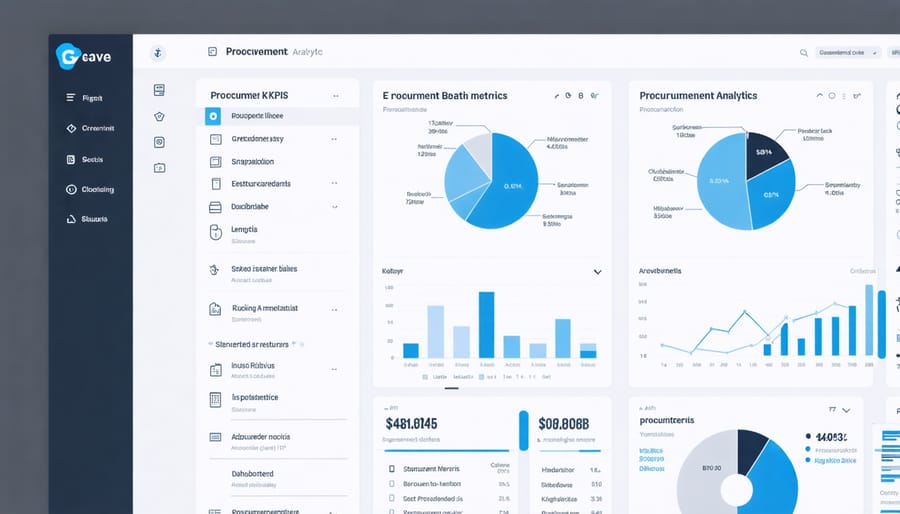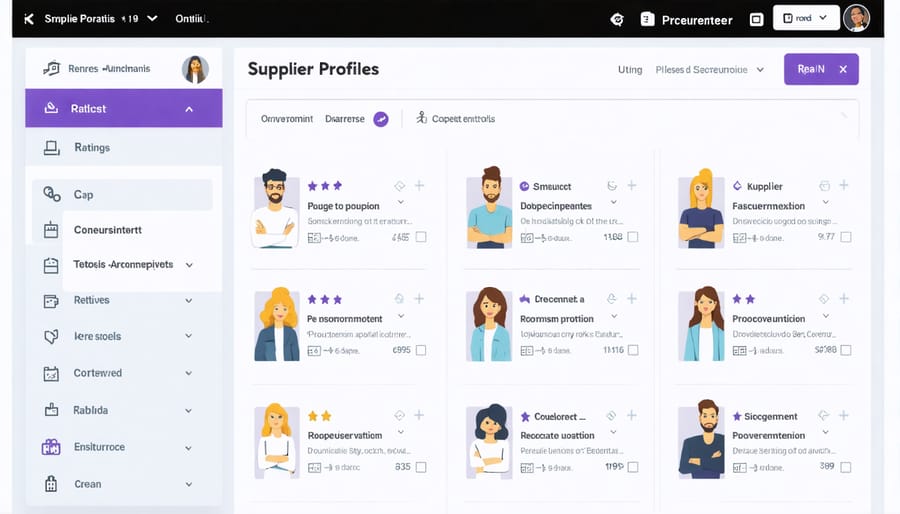E-procurement revolutionizes traditional project procurement management by digitizing the entire purchasing process, from vendor selection to payment processing. In today’s construction landscape, where efficiency and cost control are paramount, e-procurement platforms have become indispensable tools for streamlining operations and maintaining competitive advantage.
This digital transformation eliminates paper-based workflows, reduces human error, and provides real-time visibility into procurement activities across multiple construction projects. Leading construction firms report up to 35% reduction in procurement cycle times and 12% cost savings through automated procurement systems.
For construction professionals navigating complex supply chains and vendor relationships, e-procurement represents more than just technology adoption—it’s a strategic imperative that drives operational excellence. By centralizing procurement data, enforcing compliance standards, and enabling data-driven decision-making, these systems fundamentally transform how construction organizations manage their purchasing processes and vendor relationships.
Whether managing large-scale infrastructure projects or coordinating multiple job sites, e-procurement provides the digital backbone necessary for modern construction operations, ensuring transparency, efficiency, and strategic value creation throughout the procurement lifecycle.
What Makes E-Procurement Essential in Modern Construction
Digital Integration and Process Automation
Digital integration in e-procurement transforms traditional paper-based purchasing into a streamlined, automated workflow. By streamlining procurement processes, construction firms can eliminate manual data entry, reduce human error, and accelerate approval cycles. The system digitalizes key procurement activities, including purchase requisitions, vendor selection, order processing, and payment authorization.
Advanced e-procurement platforms integrate seamlessly with existing enterprise resource planning (ERP) systems, project management software, and accounting tools. This integration creates a unified digital ecosystem where procurement data flows automatically between different departments and stakeholders. For instance, when a site manager initiates a material request, the system automatically checks inventory levels, generates purchase orders, and routes them through pre-configured approval workflows.
The automation extends to vendor management, with digital catalogs, automated price comparisons, and real-time inventory tracking. Smart algorithms can analyze spending patterns, predict material needs, and suggest optimal ordering schedules. This digital transformation not only increases operational efficiency but also provides valuable data insights for strategic decision-making in construction projects.
Real-time Data and Analytics
Real-time data analytics transforms e-procurement from a simple purchasing tool into a strategic decision-making powerhouse. Modern e-procurement systems continuously collect and analyze data across the entire procurement lifecycle, enabling construction firms to make informed decisions based on actual performance metrics and market trends.
Key performance indicators (KPIs) such as supplier response times, cost variances, and delivery compliance are automatically tracked and presented through intuitive dashboards. This immediate access to procurement analytics allows project managers to identify bottlenecks, optimize spending patterns, and negotiate better terms with suppliers based on historical performance data.
Advanced analytics capabilities include spend analysis, supplier performance monitoring, and predictive modeling for future procurement needs. Construction companies can leverage this data to forecast material requirements, anticipate price fluctuations, and optimize inventory levels across multiple project sites.
The system’s ability to generate detailed reports on procurement activities helps organizations maintain compliance, track sustainability goals, and demonstrate value for money to stakeholders. This data-driven approach not only improves operational efficiency but also supports strategic planning and risk management in construction procurement processes.

Key Features of E-Procurement Systems
Supplier Management and Vendor Portals
Supplier Management and Vendor Portals form a crucial component of modern e-procurement systems, enabling construction companies to streamline their relationships with material suppliers, subcontractors, and service providers. These digital platforms create a centralized hub where organizations can evaluate, onboard, and interact with vendors through a standardized interface.
Construction firms can maintain detailed vendor profiles containing essential information such as certifications, safety records, insurance documentation, and performance metrics. The system automatically tracks supplier compliance and sends notifications when critical documents are approaching expiration, ensuring continuous regulatory adherence.
Advanced vendor portals facilitate real-time communication, allowing suppliers to respond to RFQs, submit bids, and update their catalogs independently. This self-service capability reduces administrative overhead while maintaining transparency throughout the procurement process. Suppliers can also access their payment status, historical performance data, and upcoming opportunities directly through the portal.
Quality management features enable construction companies to rate supplier performance based on criteria such as delivery timeliness, material quality, and responsiveness. This data helps in making informed decisions about vendor selection and relationship management. Integration with other project management tools ensures that supplier information flows seamlessly across different departments and project stages.
For large construction projects, these platforms often include collaborative tools that enable joint planning, forecasting, and inventory management with key suppliers, leading to more efficient supply chain operations and reduced project delays.

Purchase Order Automation
Purchase order automation revolutionizes traditional procurement processes by streamlining the entire purchasing workflow through digital systems. In construction projects, this technology eliminates manual paperwork and reduces the time spent on repetitive tasks, allowing procurement teams to focus on strategic decisions and supplier relationships.
The automated system typically follows a predetermined workflow: it initiates purchase requisitions based on inventory levels or project requirements, routes them through appropriate approval channels, converts approved requisitions into purchase orders, and sends them directly to suppliers. This systematic approach ensures consistency in purchasing procedures while maintaining compliance with organizational policies.
Advanced purchase order automation systems incorporate features such as:
– Automated three-way matching between purchase orders, receiving documents, and invoices
– Real-time budget tracking and spend analysis
– Customizable approval workflows based on order value or material type
– Integration with inventory management systems
– Digital signature capabilities for faster approvals
– Automated supplier notifications and order tracking
For construction companies, these systems prove particularly valuable when managing large-scale projects with multiple suppliers and complex material requirements. They help prevent costly delays by ensuring timely order processing and providing clear visibility into the procurement pipeline. The system also maintains a detailed audit trail of all transactions, supporting financial compliance and enabling better spend analysis.
By implementing purchase order automation, construction firms typically report a 60-80% reduction in processing time and up to 30% decrease in procurement costs, making it a crucial component of modern e-procurement solutions.
Implementation Benefits and ROI
Cost Reduction and Efficiency Gains
E-procurement systems deliver substantial financial benefits through proven cost reduction strategies and streamlined operations. Industry studies demonstrate that organizations implementing e-procurement typically achieve 5-15% reduction in direct material costs and 25-40% decrease in procurement process costs.
These savings materialize through multiple channels: elimination of paper-based processes, reduced manual data entry, automated approval workflows, and improved supplier negotiations. Construction firms report average processing cost reductions from $150 to $25 per purchase order after implementing e-procurement solutions.
Time efficiency gains are equally impressive, with procurement cycles shortened by 50-70% on average. Tasks that previously took days or weeks can now be completed in hours. For example, supplier qualification processes that traditionally required 2-3 weeks can be completed in 3-4 days through digital platforms.
The system’s ability to aggregate spending data enables better volume discounts and contract compliance, typically resulting in 8-12% savings on material costs. Additionally, automated matching of purchase orders, delivery receipts, and invoices reduces payment errors by up to 90%, minimizing costly reconciliation efforts and improving cash flow management.
These quantifiable benefits make e-procurement an essential tool for construction organizations seeking to maintain competitive advantages in today’s market.
Compliance and Risk Management
E-procurement systems play a crucial role in ensuring regulatory compliance and minimizing risks in construction projects. These platforms maintain detailed digital records of all procurement activities, creating an audit trail that satisfies regulatory requirements and facilitates transparency in bidding processes.
By automating compliance checks, e-procurement systems help organizations adhere to industry standards, government regulations, and organizational policies. The system can automatically flag non-compliant purchases, unauthorized spending, or deviation from established procurement procedures, reducing the risk of regulatory violations and penalties.
Risk management is enhanced through standardized processes and built-in controls. E-procurement platforms typically include vendor pre-qualification systems, performance tracking, and automated contract management features that help identify and mitigate potential risks before they impact project timelines or budgets.
The centralized nature of e-procurement systems allows for better monitoring of supplier relationships, contract terms, and spending patterns. This visibility enables organizations to identify potential risks such as vendor dependencies, price fluctuations, or supply chain disruptions early on. Additionally, the system’s ability to enforce segregation of duties and approval workflows helps prevent fraud and ensures proper oversight of procurement activities.
For construction firms, these compliance and risk management capabilities are particularly valuable in managing complex projects with multiple stakeholders and regulatory requirements.

Case Study: E-Procurement Success in Major Construction Projects
The successful implementation of e-procurement in the One World Trade Center construction project serves as a compelling example of how digital procurement systems can transform large-scale construction operations. During the $3.9 billion project, which spanned from 2006 to 2014, the development team implemented a comprehensive e-procurement solution that streamlined the entire supply chain management process.
The project team utilized an integrated e-procurement platform that connected over 250 suppliers and subcontractors, managing more than 12,000 purchase orders throughout the construction phase. This system enabled real-time tracking of materials, automated approval workflows, and centralized document management, resulting in a 23% reduction in procurement cycle times and an estimated cost saving of $147 million.
Key success factors included:
1. Standardized procurement processes across all project stakeholders
2. Integration with existing enterprise resource planning (ERP) systems
3. Automated vendor qualification and bid management
4. Real-time inventory tracking and materials management
5. Digital documentation and approval workflows
The system’s impact was particularly evident during the critical structural steel procurement phase, where the e-procurement platform facilitated the coordination of over 40,000 tons of steel components from multiple suppliers. The digital system’s ability to track delivery schedules, manage quality documentation, and coordinate installation sequences resulted in zero delays related to material availability.
Another notable achievement was the platform’s role in sustainability initiatives. By digitizing the entire procurement process, the project eliminated an estimated 90% of paper-based transactions, reducing both environmental impact and administrative costs. The system also enabled better tracking of sustainable materials and compliance with LEED certification requirements.
The project team reported several quantifiable benefits:
– 35% reduction in procurement administrative costs
– 45% decrease in order processing time
– 18% improvement in supplier delivery performance
– 92% reduction in order errors
– 15% increase in spend visibility and control
This case study demonstrates how modern e-procurement solutions can significantly improve efficiency, reduce costs, and enhance project control in large-scale construction projects. The success of the One World Trade Center implementation has since influenced procurement strategies in numerous other major construction projects worldwide, establishing a benchmark for digital procurement excellence in the industry.
Future Trends in Construction E-Procurement
The future of construction e-procurement is being shaped by emerging technologies that promise to revolutionize how projects are managed and materials are sourced. AI in construction management is leading this transformation, with machine learning algorithms optimizing supplier selection and predictive analytics forecasting material needs with unprecedented accuracy.
Blockchain technology is set to enhance transparency and security in procurement processes, creating immutable records of transactions and ensuring contract compliance. Smart contracts will automate payments and deliveries, reducing administrative overhead and minimizing disputes between parties.
Internet of Things (IoT) sensors and real-time tracking systems will enable better inventory management and supply chain visibility. These technologies will integrate with e-procurement platforms to provide automatic reordering and precise delivery scheduling, reducing waste and improving site efficiency.
Mobile-first solutions are becoming increasingly prominent, allowing project managers and site supervisors to approve purchases and track deliveries from anywhere. Advanced analytics and reporting tools will provide deeper insights into spending patterns and supplier performance, enabling more strategic procurement decisions.
The integration of Building Information Modeling (BIM) with e-procurement systems will create seamless workflows between design, procurement, and construction phases, ensuring that material specifications and quantities align perfectly with project requirements. This convergence of technologies will drive the industry toward more efficient, sustainable, and cost-effective procurement practices.
E-procurement represents a transformative approach to construction project management, streamlining the entire procurement process through digital solutions. As we’ve explored, implementing an e-procurement system offers substantial benefits, including cost reduction, enhanced transparency, improved supplier relationships, and more efficient document management. The data-driven insights and automated workflows enable construction companies to make informed decisions while maintaining compliance and reducing human error.
To successfully implement e-procurement, organizations should focus on comprehensive staff training, careful vendor selection, and systematic integration with existing systems. It’s crucial to establish clear procurement policies and ensure all stakeholders understand the platform’s capabilities and requirements.
Looking ahead, e-procurement will continue to evolve with emerging technologies like AI, blockchain, and IoT integration. Construction companies that embrace these digital solutions position themselves for improved operational efficiency, better cost control, and enhanced competitive advantage in an increasingly digital marketplace.
By taking a strategic approach to e-procurement implementation and maintaining focus on continuous improvement, construction organizations can achieve significant returns on their investment while building a more resilient and efficient procurement process.

